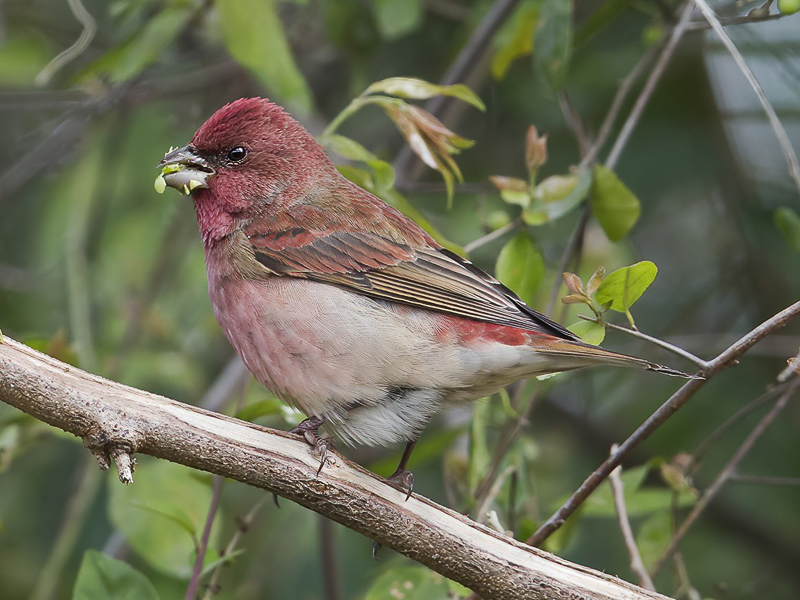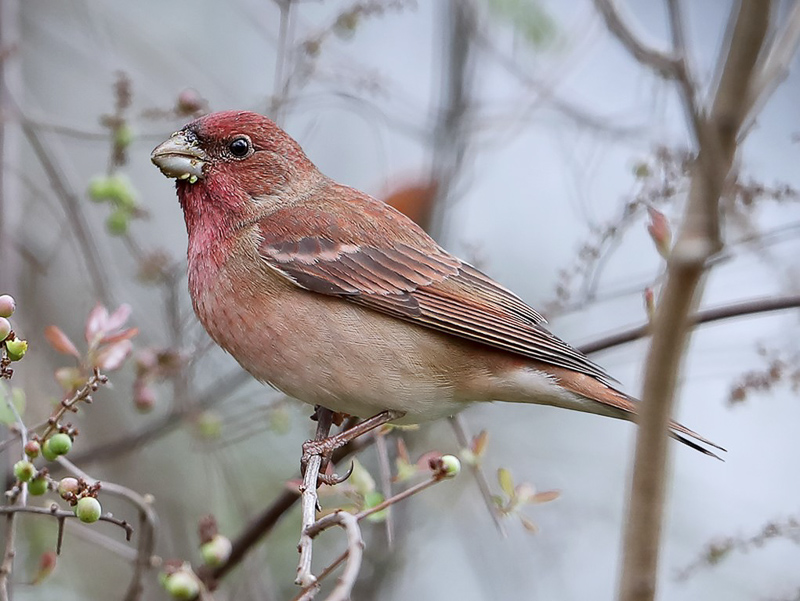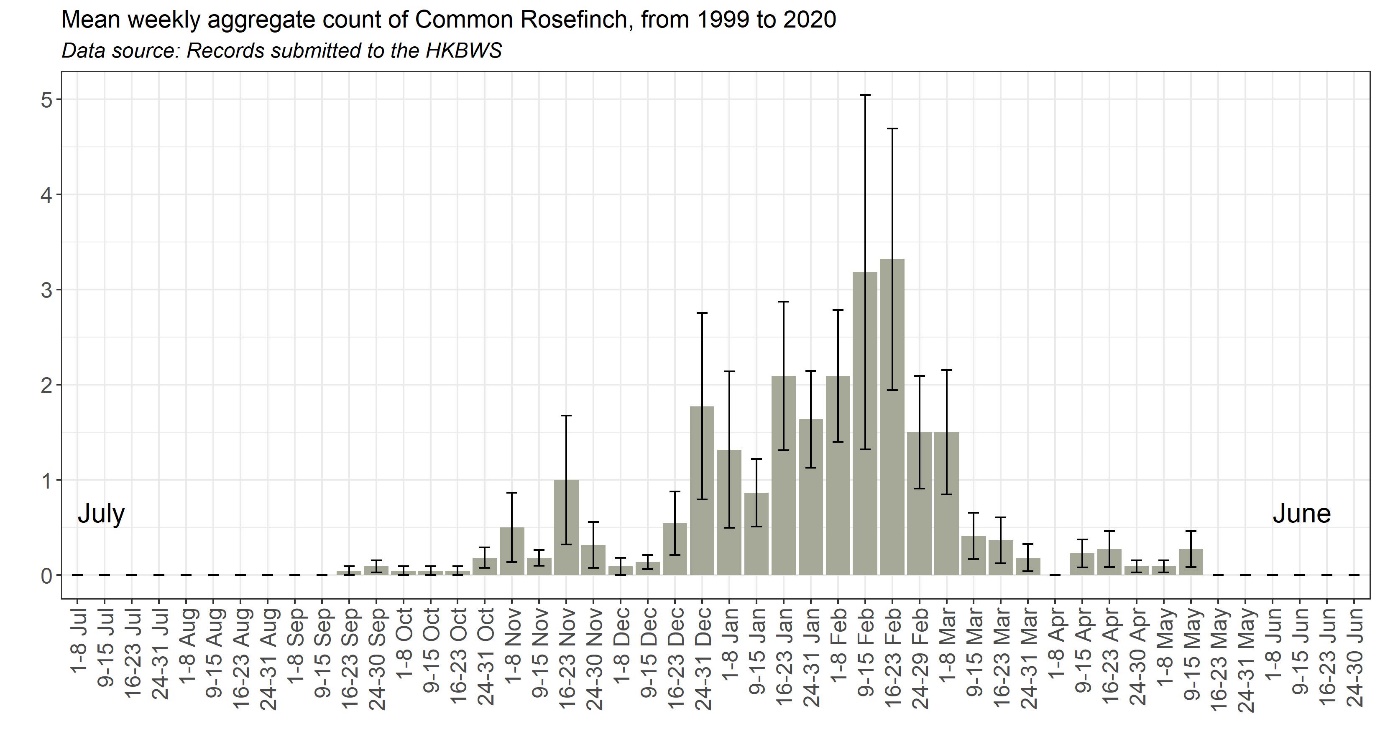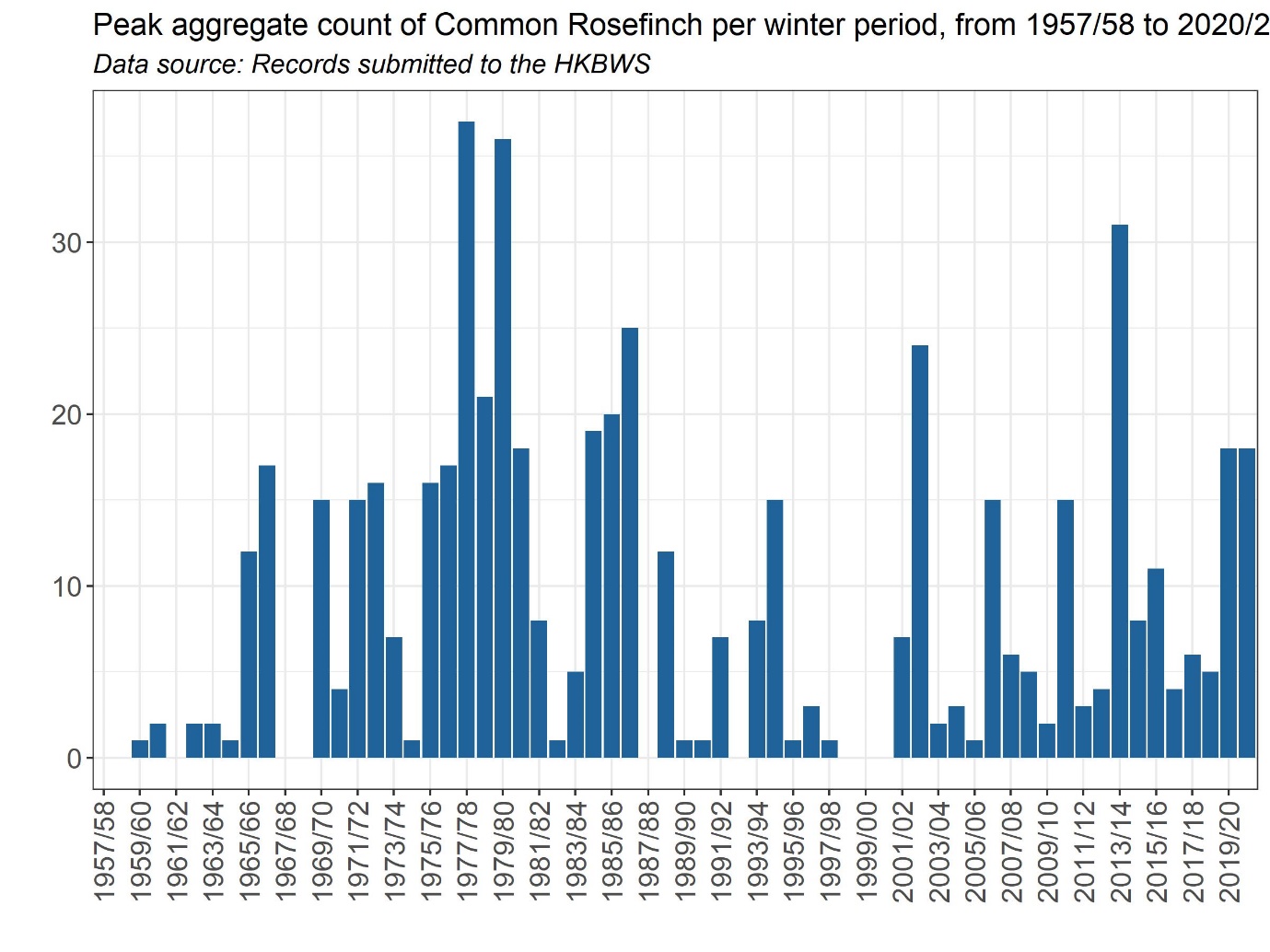Common Rosefinch Carpodacus erythrinus 普通朱雀
Category I. Scarce winter visitor and rare passage migrant, possibly declining; occurs in open country rural areas.
IDENTIFICATION

Feb. 2014, Martin Hale. Adult male.
Adult males have pinkish-red suffusion on head, upper chest and flanks, with a browner, darker broad eye stripe from bill base; mantle and back are brownish, some feathers suffused pinkish-red, and the rump is reddish.

Feb. 2014, Martin Hale. First-winter.
Female/immature is dull brown above with darker feather centres and dull pale buff below streaked brown on throat, chest and flanks. Pale tips to median and greater coverts form wing bars. The obvious olive tone to this bird and the whitish wing bars and tertials fringes suggests it is a first-winter.

Feb. 2018, Michelle and Peter Wong. Adult male.
Adult males are somewhat variable. This one has broader whiter wing bars.
VOCALISATIONS
Often heard in flight is a rising whistled note.
Also commonly heard, often as an alarm call, is an upslurred somewhat nasal ‘dzweee’.
DISTRIBUTION & HABITAT PREFERENCE
During the 1970s and 1980s small flocks of Common Rosefinches were a regular feature in areas of agricultural land in the New Territories in winter. Particularly favoured areas were Lam Tsuen valley, Shek Kong, Long Valley and Mong Tseng, suggesting that the preferred wintering habitat of the species was areas of mixed agriculture and open country. Most other records are also from areas of agricultural land, including on Lantau, but there are also reports, probably of transient birds, from shrubland sites such as Kadoorie and Mount Nicholson. In contrast, despite intensive coverage at Long Valley since at least 2010, there are rather few records.
OCCURRENCE
Common Rosefinch is a rather late migrant with relatively few records until late December (Figure 1). The earliest record is on 22 September 2019, but it remains rare until the middle of December. The wintering population is established from the last week of December to the first week of March, after which spring departure occurs. Most birds depart by mid-April; the latest observation of a bird considered to be of natural occurrence occurred on 11 May 2019. Even when this species was commonest, most counts were of fewer than ten birds; the highest concerns a flock of 33 at Shek Kong on 13 January 1980; since 1999 the highest count is 31 on 13 February 2014.
Common Rosefinch was not listed for Guangdong by Swinhoe (1861), Kershaw (1904), Vaughan and Jones (1913) or La Touche (1925-30). Thus, it does not appear to have been recorded from the Pearl River region prior to the first observation in HK in 1937 (Herklots 1937). The next record did not occur until 11 December 1947 (Herklots 1953). Walker (1958) reported it on at least four dates from 29 December to 23 March from 1955 to 1957, while the next observation, and the first in HKBWS archives, was on 1 January 1958, since when it has been recorded in most winters.
It is not clear whether the increase in numbers noted during the 1960s and 1970s was real or a consequence of improved observer coverage. However, a decline after 1987-88 was genuine as it occurred despite increasing observer activity (Figure 2). The increase this century is probably more apparent than real due to a further and larger increase in observer activity.
Whilst there has been some loss of its preferred habitat in such localities as Kam Tin and Lam Tsuen during the last ten years, this alone cannot explain the substantial decrease in numbers recorded and it is necessary to look elsewhere for an explanation. The two most likely possibilities are an increase in trapping in mainland China for the overseas cage bird trade and a withdrawal from the southern extremity of the wintering range because of milder winters.
BEHAVIOUR, FORAGING & DIET
Forages unobtrusively in rank vegetation, fruiting trees and bushes or on the ground. Feeds on a variety of seeds, fruit and flowers, and has been recorded on Bauhinia x blakeana, River Hemp Sesbania sp. and Lantana sp. Whereas the song makes it very obvious on the breeding grounds, this is heard very rarely in HK.
RANGE & SYSTEMATICS
Breeds from Scandinavia east across Russia, north Kazakhstan, north Mongolia and northeast China to Kamchatka and Sakhalin, and eastern Central Asia east to central and north China; winters from the Indian subcontinent east to south China and south to northern Indochina (Clement and Christie 2020). In China it is a summer visitor to northwest, central, southwest and northeast, and winter visitor south of the Chang Jiang (Yangtze) floodplain (Liu and Chen 2020), rarely as far north as Beijing (Birding Beijing 2022).
Polytypic, with five subspecies recognised. That considered to occur in HK is C. e. grebnitskii, which breeds in east Siberia, north Mongolia, northeast China and Korea, and winters south to Thailand and Vietnam. A bird trapped at Kadoorie on 10 November 1991 was recovered at Shenyang, Liaoning, northeast China on 15 May 1996. (Melville and Leven 1998). This bird was presumably heading towards breeding grounds further north and provides confirmation that at least some birds in HK are this subspecies.
The taxon roseatus breeds in the Himalayas east to central and south China as close to HK as Guizhou (Cheng 1987). Although subspecific plumage differentiation is weak and wintering birds cannot be separated with certainty (Clement et al. (1993)), males of the taxon roseatus are the most distinctive in being darker red than other subspecies with the red on underparts extending to flanks and belly. As yet, however, there is no evidence it occurs here.
CONSERVATION STATUS
IUCN: Least Concern. Population trend decreasing.
Figure 1.

Figure 2.

Birding Beijing (2022). https://birdingbeijing.com/the-status-of-the-birds-of-beijing/ (Accessed 20 June 2022).
Clement, P., A. Harris and J. Davis (1993). Finches and Sparrows. An Identification Guide. Christopher Helm, London.
Clement, P. and D. A. Christie (2020). Common Rosefinch (Carpodacus erythrinus), version 1.0. In Birds of the World (J. del Hoyo, A. Elliott, J. Sargatal, D. A. Christie, and E. de Juana, Editors). Cornell Lab of Ornithology, Ithaca, NY, USA. https://doi.org/10.2173/bow.comros.01
Cheng, T. H. (1987). A Synopsis of the Avifauna of China. Science Press, Beijing.
Herklots, G. A. C. (1937). Notes and Comments. Ornithology. Hong Kong Naturalist 8: 54-59.
Herklots, G. A. C. (1953). Hong Kong Birds. South China Morning Post, Hong Kong.
Kershaw, J. C. (1904). List of birds of the Quangtung Coast, China. Ibis 1904: 235-248.
La Touche, J. D. D. (1925-30). Handbook of the birds of Eastern China Vol. 1. Taylor and Francis, London.
Liu, Y. and Y. H. Chen (eds) (2020). The CNG Field Guide to the Birds of China (in Chinese). Hunan Science and Technology Publication House, Changsha.
Melville, D. S. and M. R. Leven (1988). Report on bird ringing in Hong Kong in 1996. Hong Kong Bird Report 1996: 100-113.
Swinhoe, R. (1861). Notes on the ornithology of Hong Kong, Macao and Canton, made during the latter end of February, March, April and the beginning of May 1860. Ibis 1861: 23-57.
Vaughan, R. E. and K. H. Jones (1913). The birds of Hong Kong, Macao and the West River or Si Kiang in South-East China, with special reference to their nidification and seasonal movements. Ibis 1913: 17-76, 163-201, 351-384.
Walker, F. J. (1958). Field observations on birds in the Colony of Hong Kong. Hong Kong Bird Watching Society, Hong Kong (duplicated).

